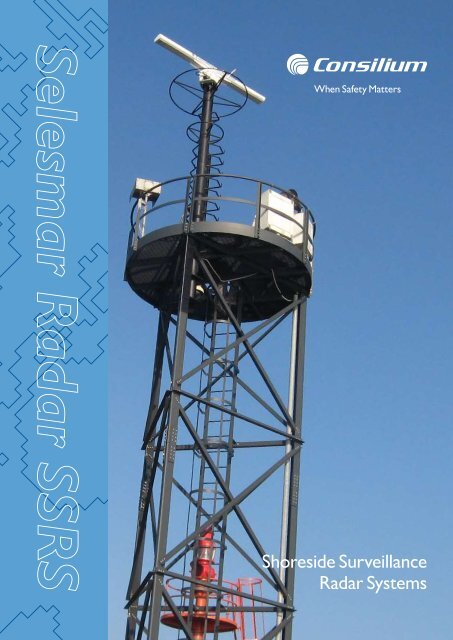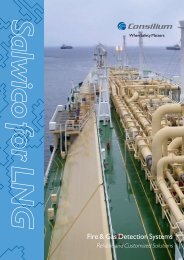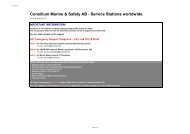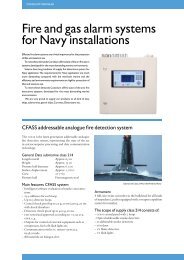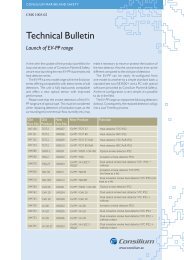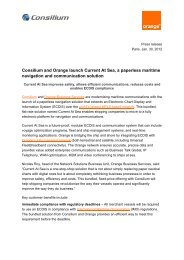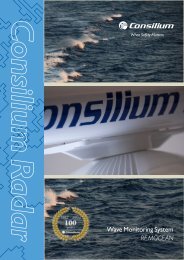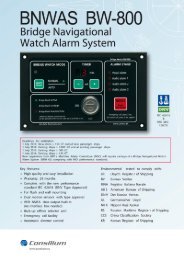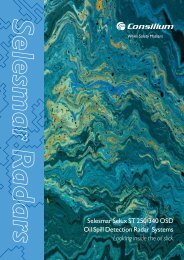Shoreside Surveillance Radar Systems - Consilium
Shoreside Surveillance Radar Systems - Consilium
Shoreside Surveillance Radar Systems - Consilium
You also want an ePaper? Increase the reach of your titles
YUMPU automatically turns print PDFs into web optimized ePapers that Google loves.
<strong>Shoreside</strong> <strong>Surveillance</strong><br />
<strong>Radar</strong> <strong>Systems</strong>
SELESMAR RADAR SSRS<br />
Shore-side <strong>Surveillance</strong><br />
<strong>Radar</strong> System (SSRS)<br />
<strong>Consilium</strong> is a major supplier of radar sensor, offering indepth<br />
knowledge of navigational radar and vts.<br />
We delivered our first radar equipment to Saint<br />
Petersburg Port Authority (Russia) in 1990; today we have<br />
delivered over 110 installations word-wide.<br />
Our SELESMAR radar solution can be delivered as part<br />
of an integrated system (vts) or as a standalone shore-side<br />
surveillance system suitable for applications such as:<br />
- Marine protected areas (marine parks)<br />
- Marinas<br />
- Oil rig platforms<br />
A Shore-side <strong>Surveillance</strong> <strong>Radar</strong> System (ssrs) mainly<br />
consists of a network of one or more <strong>Radar</strong> Sites (rs),<br />
connected to a Control Center (cc) where the scenario<br />
“as-seen” by them is fused together, thus presenting a<br />
unique vision of the area under control.<br />
The ssrs performs the following main functions related<br />
to the continuous control of the traffic situation in the<br />
surveillance area:<br />
- Monitoring of the vessels traffic and automatic warnings<br />
related to vessels violating predetermined alarm criteria.<br />
- Monitoring of the vessels in the anchoring areas, buoys,<br />
and guard zones.<br />
- Collecting information regarding vessel movement data in<br />
order to observe the ships traffic and avoid collision<br />
courses towards predetermined fixed installations such as<br />
oil platforms.<br />
- Increasing the navigation safety and preventing environ<br />
mental pollution.<br />
- Supporting Search and Rescue (sar) operations.<br />
History<br />
The concept of managing ship movements via a shore-side<br />
radar station first appeared in 1949 at the Port of Liverpool,<br />
England. In 1956, the Netherlands established a system of<br />
radar stations for the surveillance of traffic at the port of<br />
Rotterdam.<br />
Since then the concept has rapidly evolved and a number of<br />
additional sensors have been integrated with the radar. These<br />
sensors are cctv, Automatic Identification System (ais),<br />
telecommunication, meteo etc connected by a data network<br />
to a Control Center.<br />
This system is known as Vessel Traffic Service (vts), or<br />
sometimes Vessel Traffic Management & Information System<br />
(vtmis). A vts is defined by the International Maritime<br />
Organization as “a service implemented by a Competent<br />
Authority designed to improve safety and efficiency of vessel<br />
traffic and to protect the environment. The service should have<br />
the capability to interact with traffic and respond to traffic<br />
situations developing in the vts area.” (imo res. a.587 20).<br />
The main target for a vts is to identify and proactively<br />
manage risks in order to improve safety, efficiency and security<br />
of maritime operations and its infrastructure by providing<br />
optimal situational awareness.<br />
Typical application of vts is the monitoring of harbors,<br />
territorial waters and exclusive economic zones.<br />
Customer Support<br />
<strong>Consilium</strong> has developed, designed, delivered and commissioned<br />
Shore-side <strong>Radar</strong> <strong>Surveillance</strong> <strong>Systems</strong> for more than<br />
20 years, either as standalone equipment or as part of complex<br />
Vessel Traffic Services to the major system integrators worldwide.<br />
Since our first delivery to Saint Petersburg Port Authority<br />
we have gained a great deal of knowledge in this specific<br />
market segment. Today our experience includes delivering<br />
installations to China, Mexico, Spain, India, Argentina, France,<br />
United Kingdom, Finland, Norway, Russia and Italy.<br />
We are committed to delivering first-class solutions and<br />
providing our customers with first-class support throughout<br />
the entire product life cycle.<br />
Our Customer Service provides an integrated logistic<br />
support that includes:<br />
- 24/7 full service support at all locations, using our interna<br />
tional service network<br />
- 365/365 telephone help-desk<br />
- spare parts delivery to all destinations within 24 hours after<br />
the receipt of order<br />
- training courses for operators and maintenance engineers<br />
either at our Training Centre or at Customers’ locations<br />
- on site inspection and evaluation of existing installations for<br />
refitting solutions with full backward compatibility<br />
SELESMAR RADAR SSRS
SELESMAR RADAR SSRS SELESMAR RADAR SSRS<br />
System description<br />
System Configuration<br />
The Selesmar ssrs configuration is based on an open<br />
architecture consisting of:<br />
- one or more <strong>Radar</strong> Sites (rs), including the Antenna<br />
Group, the Transceiver, the <strong>Radar</strong> Site Controller (rsc)<br />
and the Service Display;<br />
- one or more Operator Workstations (ows’s);<br />
- link between rs’s and Control Center (cc)<br />
Thanks to the modular structure, the system can be<br />
expanded by adding extra rs’s or Operator Workstations in<br />
local or remote position.<br />
Each RS can be operated in unmanned mode remotely<br />
controlled by the Workstation, by exchanging data via<br />
an extended lan using a standard tcp/ip protocol. The<br />
video extraction, target detection, tracking and video<br />
conversion in digital form are performed at the <strong>Radar</strong> Site,<br />
thus allowing the use of narrow band link to transfer the<br />
Tracked Data and the digitalized Video to the workstation<br />
for an accurate presentation of a synthetic and clear radar<br />
picture.<br />
Each Operator Workstation has the same capability<br />
in terms of performance, but in the case of a wider<br />
configuration one can be selected as supervisor of the<br />
system.<br />
The customer can choose from a variety of cost-effective<br />
link options between <strong>Radar</strong> Site (rs) and Control Center<br />
(cc)<br />
- By utp (Unshielded Twisted Pair)/stp (Shielded Twisted<br />
Pair) cable with switch/router connection, whenever<br />
the various modules can be installed in a close position<br />
(maximum 100 m distance between rs and cc).<br />
- DSL line 640K bps<br />
- WIFI or WAN connection<br />
- Optical fibers<br />
- Microwave link with router<br />
One of the main tasks of the Control Center is running<br />
the application software of the ssrs Operator Workstation,<br />
programmed in C language and operated under a Linux<br />
Operating System.<br />
The choice for this operating system has been driven by its<br />
unique advantages:<br />
- Really open system allowing software portability on<br />
hardware platforms more powerful and sophisticated than<br />
Intel pc’s. It is used in many high professional applications.<br />
- Very flexible X-Window graphic environment allowing<br />
an easy connection to other consoles.<br />
- Because Linux architecture is not very well known there<br />
is far less likelihood of software security breaches.<br />
The SSRS system involving more than one (two) Operator<br />
Workstations, is completed by a System Processing Unit<br />
(SPU) in order to make possible the correct assignment of<br />
the operative tasks to each Operator Workstation.<br />
Only one spu is needed to manage the task assignment<br />
in a ssrs System and the installation is possible anywhere,<br />
regardless the number of Operator Workstations and<br />
depending only on where the customer want to have the<br />
“decision center” and the SSRS supervisor.<br />
Redundancy at all levels<br />
Being a critical application, a number of redundanc solutions<br />
have been implemented in the <strong>Consilium</strong> ssrs to improve<br />
the system availability.<br />
<strong>Radar</strong> Site<br />
Two Transceivers operating in the same frequency, X Band,<br />
provide the needed redundancy allowing full operation<br />
with at least one Transceiver and possibility to carry-out<br />
planned maintenance without affecting the operative<br />
functions.<br />
Similar redundancy can be provided by a dual X & S<br />
Band <strong>Radar</strong> Sensor allowing the proper performance in all<br />
weather conditions.<br />
As option, the rsc can be made redundant too by using a<br />
dual electronic set.<br />
Control Center<br />
The redundancy of the cc is provided by installing more<br />
Workstations linked to the same lan and performing same<br />
functions assigned by the VTS operator by properly setting<br />
the System Processing Unit (spu) acting as a system server.<br />
The spu can be redundant too, both computers working<br />
together processing and storing all data, but only one<br />
being master and sending/receiving data to/from the<br />
radars and consoles. In case of failure, after 10 seconds of<br />
communication lack from the network, the other spu server<br />
takes the control.<br />
Manning<br />
The <strong>Radar</strong> Site can be operated in an unmanned mode<br />
directly from the Control Center where the radar status can<br />
be remotely monitored and controlled by the vts operator.<br />
For service purpose only, a Service Display, based on a<br />
portable Lap-top pc, is supplied in order to make possible<br />
a local control of the radar site and the adjustment of<br />
relevant parameters with reference to a digitalized video<br />
presentation.<br />
Such Service Display can be moved site by site depending<br />
on the need for maintenance or corrective services.<br />
Expansion capability<br />
Due to the ssrs open architecture and modular design,<br />
future expansion is easily accommodated, whether it involves<br />
the addition of sensors, relocation of existing component<br />
or additional functionalities.
SELESMAR RADAR SSRS<br />
Geographical Processing<br />
The Selesmar ssrs makes possible to define geographical areas to distinguish between processing modes in terms of video<br />
generation, tracking and target detection.<br />
Geographical Processing mode<br />
GEOGRAPHICAL AREA VIDEO PROCESSING<br />
& DISPLAYING<br />
Littoral Mask<br />
- Defined shore areas<br />
Land Mask<br />
- Masking out land areas<br />
Auto-Acquisition<br />
- Defines areas for auto acquiring<br />
<strong>Consilium</strong> SSRS Features<br />
Enabled Disabled<br />
Disabled Disabled<br />
TARGET DETECTION<br />
ACQUISITION & TRACKING<br />
Enabled Enabled in manual & automatic mode<br />
FEATURE STANDARD OPTIONAL<br />
Linear Polarised Antenna<br />
Circular Polarised Antenna<br />
AIS interface<br />
- Yes<br />
Tx nominal peak power X band<br />
25 kW<br />
Tx nominal peak power S band 30 kW<br />
Max number of radar sites 4 More<br />
Tracking capability for each radar site 500 targets Extended<br />
Recording and Replaying 7 days Extended<br />
CONSILIUM RADAR<br />
SSRS Units and and main functions<br />
<strong>Radar</strong> Site/s<br />
Antenna Group & Transceiver<br />
The Antenna Group & the Transceiver, combined together, are the “active<br />
sensor” of the SSRS assuring the radar surveillance and target detection in<br />
the assigned area.<br />
Antenna Control Unit (ACU) for Dual Transceiver configuration only<br />
Since the Antenna driver is always powered by the Transceiver electronics,<br />
the ACU is needed whenever same antenna group can be powered by<br />
different Transceivers (redundant configuration only).<br />
Either under the local control of the service display, or the remote<br />
control originated by the control center, the ACU makes possible the right<br />
combination between the selected Transceiver and the common antenna<br />
group.<br />
<strong>Radar</strong> Site Controller (SELUX RSC)<br />
The RSC performs the following main functions:<br />
- Video processing<br />
- Scan conversion<br />
- Target extraction<br />
- Target Tracking<br />
- Local <strong>Radar</strong> control<br />
- Performance monitoring<br />
- Transmission to the Workstation of<br />
- Tracked Target Data<br />
- Digitalized Video<br />
- <strong>Radar</strong> Status<br />
- Alarms<br />
- Receiving <strong>Radar</strong> Control and Setting from Control Center:<br />
- transceiver selection (X or S), (in the extended multiple configuration<br />
only)<br />
- transceiver on/off;<br />
- PRF and Pulse length setting<br />
- receiver tuning<br />
- STC and FTC controls<br />
- talarm criteria<br />
Service Display (Lap-top PC)<br />
- Local radar presentation<br />
- Local radar control and setting-up<br />
- Service<br />
Control Center<br />
Operator Workstation<br />
- Data reception from one or more radar sites through LAN<br />
- Rebuilding the video radar image<br />
- Providing the presentation of the electronic chart related to the surveyed<br />
area<br />
- Overlapping the combined video radar image onto the electronic chart<br />
- Presentation of the tracked radar targets<br />
- Presentation of the Tracked AIS Target<br />
- <strong>Radar</strong> surveillance and monitoring of the surrounding area: anchoring<br />
areas, buoys, channels and guard zones<br />
- Automatic warnings related to vessels breaking predetermined<br />
alarm criteria<br />
- Printing (from the operator console) of screen/target data<br />
Additional functions as specified below are performed by the same<br />
station in case of single radar site linked to one workstation only.<br />
System Processing Unit (SPU)<br />
The System Processing Unit (SPU) is a “server” station operated by the VTS<br />
supervisor when more than one Operator Workstation is involved in the<br />
VTS configuration.<br />
Global Service Network<br />
<strong>Consilium</strong> Navigation is represented in more than 50<br />
countries and has a presence in the most frequently<br />
used ports around the world. Customers are able to<br />
obtain spare parts or conduct servicing via the network<br />
of subsidiaries and agents so no matter where<br />
they are they’re never far from a <strong>Consilium</strong> expert.<br />
After sales support you can rely on<br />
<strong>Consilium</strong> prides itself on providing customers with<br />
the benefit of a highly trained and resourceful after<br />
sales team. Each member of the team is fully experienced<br />
so customers have the added assurance of<br />
knowing that when they buy from <strong>Consilium</strong> complete<br />
customer satisfaction is an essential part of the<br />
deal.<br />
SELESMAR RADAR SSRS<br />
In case of VTS including one workstation only, the following functions are<br />
processed by the Operator Workstation using the resources provided by<br />
the same computer.<br />
Task assignment<br />
This function allows the VTS supervisor to assign different operative tasks<br />
in a control center with different Operator Workstations.<br />
<strong>Radar</strong> Control (local or remote) and Setting<br />
- Transceiver on/off<br />
- RTM selection (X or S), in the extended configuration only<br />
- PRF and Pulse length setting<br />
- Receiver tuning<br />
- STC and FTC<br />
Ships Database handling<br />
Information relevant to tracked targets such as name, international<br />
call sign, type of vessel, characteristics, dimensions, etc., are stored in a<br />
permanent database. Stored data can be automatically retrieved at time<br />
of identification carried out by the operator.<br />
Multi-sensor-tracking management.<br />
The multi-radar-tracking is the function at system level allowing the<br />
correlation of data relevant to the same tracked target being “seen” by<br />
two or more radar systems. The same function and the same logic are<br />
also correlating the information made available by ship-borne Automatic<br />
Identification System (AIS).<br />
Recording<br />
Continuous recording and storing of the last 7 days history on hard disk<br />
for:<br />
- tracked targets data, from both AIS and radar source<br />
- digital video from all radars<br />
Replaying<br />
This function can be enabled on all VTS workstations without interference<br />
with other modules in the VTS. The following replaying functionality can be<br />
provided:<br />
- Fast forward and reverse<br />
- Stop<br />
- Stand still picture<br />
- Play (real time speed)<br />
- Adjustable play speed, up to 50 times normal speed<br />
- Time search functions, by year / month / date / time<br />
- Provision to print user selected views<br />
SSRS Data Link<br />
Since the video processing, extraction, tracking and video conversion<br />
in digital form are performed at the radar site, the most significant data<br />
exchange between the radar site and the control center is reduced to the<br />
transfer of the tracked data and the digitalized video map. Therefore it is<br />
possible to use a narrow band link.<br />
As already mentioned, the customer can select among a variety of<br />
cost-effective link options between the RS and CC:<br />
- direct connection via UTP/STP cable, whenever the various modules<br />
can be installed in a close position (maximum 100 m distance between<br />
RS and CS).<br />
- DSL line 640K bps<br />
- WIFI or WAN connection<br />
- Optical fibers<br />
- Microwave link with router<br />
As standard, the data links are not included in the proposed scope of<br />
supply, in order to leave the customer free to select the most convenient<br />
solution and service provided by other telecommunication companies.<br />
Training on demand<br />
To help customers to get the most out of their equipment<br />
<strong>Consilium</strong> provides comprehensive educational<br />
courses and training seminars from their global<br />
network of offices. So should a customer have a<br />
special requirement <strong>Consilium</strong> representatives can<br />
help make all the necessary arrangements to conduct<br />
teaching seminars where attendees can discover<br />
everything there is to know about a particular product<br />
and its functions.
<strong>Consilium</strong> Marine Group - You find us world wide<br />
<strong>Consilium</strong> Offices<br />
Sales & Service Representatives<br />
SWEDEN<br />
<strong>Consilium</strong> Marine AB<br />
Gothenburg<br />
Phone: +46 31 710 77 00<br />
Fax: +46 31 710 78 00<br />
<strong>Consilium</strong> Navigation AB<br />
Nacka<br />
Phone: +46 08 563 05 100<br />
Fax: +46 08 563 05 199<br />
www.consilium.se<br />
Ft Lauderdale<br />
CHINA<br />
<strong>Consilium</strong> Shanghai Co. Ltd.<br />
Shanghai<br />
Phone: +86 21 5152 22 60<br />
Fax: +86 21 5152 22 90<br />
Dalian<br />
Phone: +86 411 8690 4807<br />
Fax: +86 411 8690 4807<br />
FINLAND<br />
<strong>Consilium</strong> Marine OY<br />
Helsinki<br />
Phone: +358 405 25 28 25<br />
Fax: +358 425 25 28 25<br />
GERMANY<br />
<strong>Consilium</strong> GmbH<br />
Hamburg<br />
Phone: +49 40 822 22 95-0<br />
Fax: +49 40 822 22 95 99<br />
GREECE<br />
<strong>Consilium</strong> Marine Hellas<br />
Piraeus<br />
Phone: +30 210 428 7097/8<br />
Fax: +30 210 428 7165<br />
INDIA<br />
<strong>Consilium</strong> India Pvt. Ltd.<br />
Mumbai<br />
Phone: +91 2267935150-53<br />
Fax: +91 2267937921<br />
Rochester<br />
Folkestone<br />
Bilbao<br />
Vigo<br />
Algeciras<br />
New Orleans<br />
Stockholm<br />
Gothenburg<br />
Oslo<br />
Rotterdam<br />
Naples<br />
Valencia<br />
Florence<br />
Genua<br />
Barcelona<br />
Las Palmas<br />
ITALY<br />
<strong>Consilium</strong> Marine Italy Srl.<br />
Florence<br />
Phone: +39 0571 68121<br />
Fax: +39 0571 670 798<br />
Genova<br />
Phone: +39 010 5533900<br />
Fax: +39 010 5533990<br />
Naples<br />
Phone/Fax: +39 08154 23122<br />
JAPAN<br />
<strong>Consilium</strong> Nittan Marine Ltd<br />
Tokyo<br />
Phone: +81 03 5465 1881<br />
Fax: +81 03 5465 1887<br />
NETHERLANDS<br />
<strong>Consilium</strong> Marine <strong>Systems</strong> BV<br />
RK Schoonhoven<br />
Phone: +31 182 382 422<br />
Fax: +31 182 386 675<br />
NORWAY<br />
<strong>Consilium</strong> Norway AS<br />
Oslo<br />
Phone: +47 22 30 90 30<br />
Fax: +47 22 30 92 05<br />
SPAIN<br />
<strong>Consilium</strong> RMI Spain S.A.<br />
Bilbao<br />
Phone +34 94 404 2121<br />
Fax: +34 94 404 212<br />
Hamburg<br />
Helsinki<br />
Piraeus<br />
Doha<br />
Dubai<br />
Mumbai<br />
Hanoi<br />
Singapore<br />
SPAIN cont.<br />
Algeciras<br />
Phone: +34 956 60 20 66<br />
Fax: +34 956 60 13 04<br />
Las Palmas<br />
Phone: +34 928 46 55 60<br />
Fax: +34 928 47 57 76<br />
Vigo<br />
Phone: +34 986 24 51 55<br />
Barcelona<br />
Phone: +34 93 469 04 19<br />
Fax: +34 93 469 41 36<br />
Valencia<br />
Phone;: +34 661 81 00 61<br />
Fax: +34 963 76 27 84<br />
SINGAPORE<br />
<strong>Consilium</strong> Marine<br />
Singapore Pte. Ltd.<br />
Singapore<br />
Phone: +65 6251 6016<br />
Fax: +65 6251 6017<br />
SOUTH KOREA<br />
<strong>Consilium</strong> Marine Korea Ltd.<br />
Pusan<br />
Phone: +82 51 740 5869/71-3<br />
Fax: +82 51 740 5870<br />
QATAR<br />
<strong>Consilium</strong> Qatar LLC<br />
Doha<br />
Phone +974 466 53 32<br />
Fax: +974 466 54 62<br />
Pusan<br />
Dalian<br />
Tokyo<br />
Shanghai<br />
Ho Chi Minh<br />
UAE<br />
<strong>Consilium</strong> Middle East (FZC)<br />
Sharjah<br />
Phone: +971 6 55 70 740<br />
Fax: +971 6 55 70 741<br />
UK<br />
<strong>Consilium</strong> Marine UK<br />
Rochester<br />
Phone: +44 1268 41 77 45<br />
Fax: +44 1268 41 70 51<br />
Glasgow<br />
Phone: +44 1355 570 952<br />
USA<br />
<strong>Consilium</strong> Marine US<br />
Fort Lauderdale<br />
Phone: +1 954 791 7550<br />
Fax: +1 954 791 7599<br />
New Orleans<br />
Phone: +1 954 610 0884<br />
VIETNAM<br />
<strong>Consilium</strong> Vietnam JSC<br />
Hanoi<br />
Phone: + 84 4 37 93 14 31<br />
Fax: + 84 4 37 93 14 32<br />
Ho Chi Minh City<br />
Phone: + 84 8 410 13 38<br />
Fax: + 84 8 410 13 39<br />
2009.09


